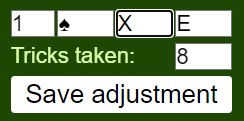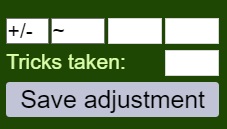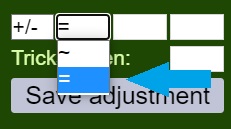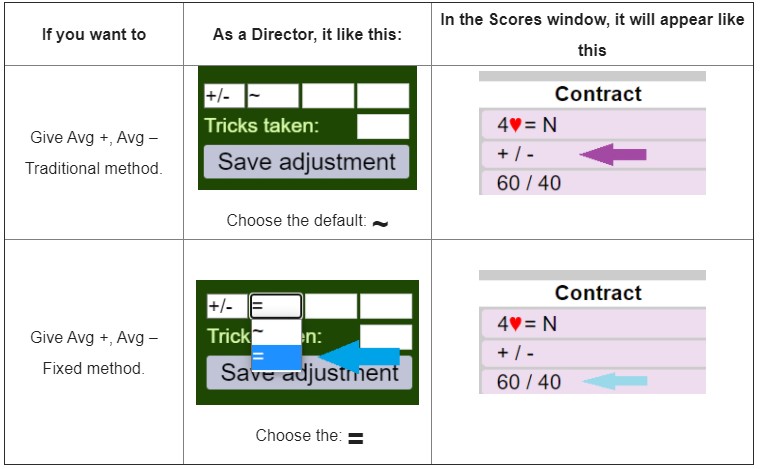This guide is for those who have already seen Running an event. After you have looked here, at this chapter, we recommend that you look at these chapters:
changed 14 April 2023
You can assign any single result to a board, either as an assigned score or an artificial score.
You can also apply changes to a contestant's overall score.
To assign an adjusted score, navigate to the bidding and play record for the board at the given table. For example, go to the pair's scorecard, then click on the contract currently shown.
In the top right-hand corner are controls for adjusting the score.
To assign a real score, use the five boxes to specify the level, contract, whether it was doubled or redoubled, declarer, and number of tricks. Then click Save adjustment.

To give an artificial adjusted score, use the same controls as above.
It is possible to assign fixed and variable artificial scores. Scores with symbols (+, =, -) are variable and numbers (40, 50, 60) are fixed. For example, if a pair is given Avg+, they get 60% or their own score, whichever is higher. If a pair is given 60, they get 60% always. Similarly for Avg- and 40%.
When adjusting the score, the first box contains +/-, +/=, etc. The second box controls which type of adjustment is made:
~ means that the score is Avg+/Avg-
= means that the score is fixed 60%/40%
The adjustments are in the order NS/EW, so +/= means Avg+ for NS, Avg= for EW.


The image on the left shows Avg + for North/South and Avg - for East/West. Notice the ~ symbol which indicates that the scores change based on the session score for the pair.
In the USEBIO file, the matchpoints are calculated according to the adjustment you have specified. However, the SCORE will show the same text, eg “A6040”, for both types of adjustment. This is because the USEBIO format does not support both types of adjusted score. Many scoring systems do not have this feature. If you choose to import the USEBIO file into a scoring application and rescore it, it may rescore a 60/40 as an Avg+/Avg-.

The subject of “multiple adjustments for one pair” is handled differently by some score systems. The method we have used is consistent with the wording of the laws, and verified by a WBF committee member. We compute scores like this:
For teams, the minus infractions Avg- results in minus three IMPs (-3). The adjustment is only applied to one side.
For X-IMPs, the minus infractions, Avg- results in minus two IMPs (-2). The Avg+ is plus two (+2).
If the adjustment "balances" then it goes in the normal IMP score columns. That is:
If the adjustment doesn't balance then the IMP score for the board is 0 and the adjustments go in the (invisible) separate column - so the total scores / VPs will be correct.
For head-to-head matches, ONLY =/=, +/- and -/+ are selectable.
For more about this topic please refer to EBU White Book
The simplified rule is this:
If a pair doesn't play a board that they are scheduled to play, Law 12 requires the director to award an adjusted score (eg. average, average plus, average minus).
A pair left the event. No substitute can be found, some rounds need to be skipped.
In the English Bridge Union: the EBU Whitebook (2.4.4) states: If a contestant withdraws before half of the session is completed, all scores obtained against that contestant are cancelled. If a contestant withdraws after completing half of the session, all scores obtained against the withdrawn contestant stand. Any contestant required to ‘sit out’ as a result of the withdrawal receives AVE+. In RealBridge this means:
Outside the English Bridge Union: follow the guidance of your national bridge organisation.
You can apply adjustments to a contestant’s overall score. This is used for applying handicaps, corrections to carryovers, artificial match scores (eg 12-0 in VPs for a forfeited match), procedural penalties, and weighted adjusted scores.
The image below shows the Scores screen, with the Adj column containing adjustments.
The Director always sees the Adj column, even if it is empty.
Players see the Adj column only if there is at least one adjustment.
To apply an adjustment, the director simply clicks in the Adj column for the relevant contestant (pair or team, depending on the type of session) and types in the adjustment. The adjustment should be entered in units of:
An adjustment can be negative or positive, and can be a decimal number.
Before adjustment to pair 5:

After adjustment to pair 5:

Notice that the matchpoints column does not change. The matchpoints column contains the matchpoints before this adjustment. The percentage shown does change, as this represents their score after applying the adjustment.
In this example, after subtracting 3 matchpoints their percentage is (53-3)/84 = 59.52%
If a contestant receives multiple adjustments, the Adj column contains the total of all their adjustments. For example, if they already have an adjustment of -3, and you want to apply a further adjustment of -6, change the Adj column to -9.
This functionality is intended only for adjusting the overall score of a contestant. To adjust the score on a single board, go to the result in the Scores window and adjust the score there, as described above.
An overall score adjustment appears in a USEBIO file as an ADJUSTMENT node for the contestant.